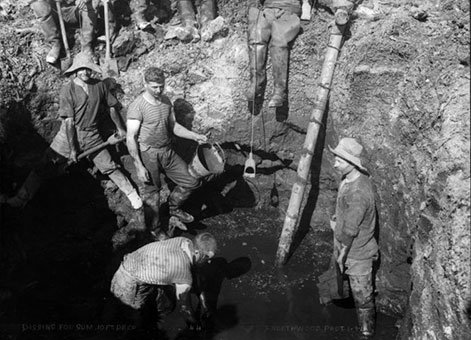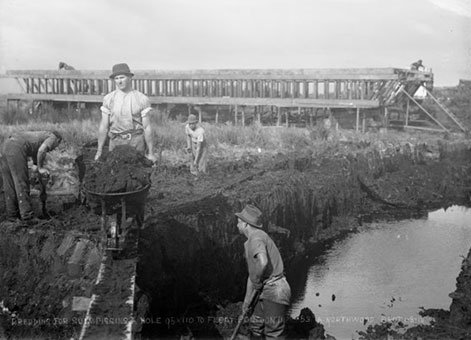Kauri trees (Agathis australis) are unique to New Zealand and have grown here for more than 150 million years. Kauri grew throughout New Zealand prior to the Ice Age, but with this shift in climate their growth became restricted to the warmer, sub-tropical, northern regions of the country. Over time Kauri trees grew, died and decayed, leaving behind a resinous gum. This buried gum was often found in swamps, where special techniques were needed to retrieve it.

Digging for gum, Northland [1 August 1911], Ref; 1/1-011220-G, Alexander Turnbull Library, Wellington, New Zealand.
Why mine for Kauri gum?
In AH Reed’s book, The Gumdiggers, it is estimated the Kauri gum industry was valued at £25 million ($306.7 million in 2012 value), and this laid the foundation for the prosperity of northern New Zealand in the late 19thand early 20th Centuries. Until 1914 Kauri gum was the largest mineral export from New Zealand.
Kauri gum was not used in New Zealand to manufacture products, but there was international demand for the resin. Brown, Campbell and Company, Auckland merchants, were able to export Kauri gum to the United States of America, and later the United Kingdom, where it was used in the manufacture of high quality wood varnish. Lower quality gum was also used in linoleum.

Gum diggers in Subritzky;s field, near Awanui [1914], Ref; 1/1-009783-G, Alexander Turnbull Library, Wellington, New Zealand.
Early exports were recorded in 1853 when 800 tons was exported at a value of £16,000, followed in 1854 by the export of 1,700 tons at a value of £29,000. This steadily increased. However, from the mid 1930s Kauri gum was progressively replaced by synthetic resins, and the Kauri gum industry died out as a result of the lack of demand.
Finding and digging the Kauri gum
Initially Kauri gum could be gathered on the surface or by digging a short way into the soil. Like gold mining, many people were attracted to the gum fields to make money with minimal outlay for equipment. There were many grades of gum, each fetching a different price according to its quality.
Māori were the first collectors of gum but by the 1890s it was estimated there were 4,000 Europeans and 1,000 Māori collecting gum in Northland.

Gum diggers washing kauri gum [1911], Ref; 1/1-004961-G, Alexander Turnbull Library, Wellington, New Zealand.
As the price of gum increased between 1880 and 1925, it became economical to systematically drain and excavate swamp land to recover as much gum as possible, using mechanical means to wash the dirt from the gum. The excavation was by manual labour.
Fred Matich, Ivan Matich and Des Mataga, who have had a long interest in Kauri gum mining, presented a fascinating technical paper on the engineering aspects of the subject to the 16th Engineering Heritage Conference in Hobart November 2011.
Find out more
Visit the Kauri Museum 5 Church Road, RD 1, Matakohe, Northland.
Further reading
M Brown and A Spoelstra (eds.), The Figs and the Vines: gumdigging in Kaipara, Dargaville, 1997.
Fred and Ivan Matich, and Des Mataga, “Mining Buried Resin (Kauri Gum) – an Engineering Perspective”, Proceedings of the 16th Engineering Heritage Australia Conference, 2011.
AH Reed, The Gumdiggers - the Story of Kauri Gum, Reed, Wellington, 1972.
Carl Walrond, “Kauri gum and gum digging”, Te Ara - the Enclopedia of New Zealand, last modified 1 March 2009.
Location
5 Church Road, RD 1, Matakohe.
